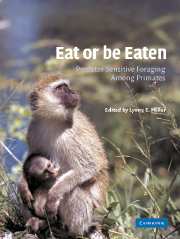Book contents
- Frontmatter
- Contents
- List of contributors
- Preface
- 1 An introduction to predator sensitive foraging
- PART I BIOLOGICAL VARIABLES
- 2 Dangers in the dark: Are some nocturnal primates afraid of the dark?
- 3 Predation sensitive foraging in captive tamarins
- 4 Seeing red: Consequence of individual differences in color vision in callitrichid primates
- 5 Predator sensitive foraging in Thomas langurs
- PART II SOCIAL VARIABLES
- PART III ENVIRONMENTAL VARIABLES
- Index
4 - Seeing red: Consequence of individual differences in color vision in callitrichid primates
Published online by Cambridge University Press: 10 November 2009
- Frontmatter
- Contents
- List of contributors
- Preface
- 1 An introduction to predator sensitive foraging
- PART I BIOLOGICAL VARIABLES
- 2 Dangers in the dark: Are some nocturnal primates afraid of the dark?
- 3 Predation sensitive foraging in captive tamarins
- 4 Seeing red: Consequence of individual differences in color vision in callitrichid primates
- 5 Predator sensitive foraging in Thomas langurs
- PART II SOCIAL VARIABLES
- PART III ENVIRONMENTAL VARIABLES
- Index
Summary
Introduction
Behavioral adaptations are mediated by the sensory systems. Animals locate food, identify mates, and avoid predators when they see, hear, smell, or otherwise sense them. It is easy to take for granted the fact that the sensory systems are directly and strongly influenced by selection pressures, but the identification of those pressures and the resulting adaptations sheds light on behavior we wish to understand. In this chapter the ways in which individual differences in one particular sensory adaptation, color vision, may influence foraging and predator detection in callitrichid primates are described. It is argued here that predation sensitive foraging may be accomplished in ways unique to callitrichids and other primate species that display this interesting sensory polymorphism.
Sensory specialization and compromise
Sensory systems often reflect a compromise resulting from different, sometimes opposing, selection pressures. A familiar and excellent example of this fact is the response of the visual system to selection pressures associated with diurnal versus nocturnal life. When light is plentiful, the eye can afford to specialize in the detection of detail in the visual world. In the absence of light, the eye must do what it can to capture and respond to every bit of illumination, even though such sensitivity sacrifices the visual detail enjoyed by diurnal species. Diurnal and nocturnal eyes are different in a host of ways, but most fundamentally they differ in the relative number of the two types of photoreceptors: rods and cones. Rods have a lower threshold to light than do cones and thus function when cones do not.
Information
- Type
- Chapter
- Information
- Eat or be EatenPredator Sensitive Foraging Among Primates, pp. 58 - 73Publisher: Cambridge University PressPrint publication year: 2002
Accessibility standard: Unknown
Why this information is here
This section outlines the accessibility features of this content - including support for screen readers, full keyboard navigation and high-contrast display options. This may not be relevant for you.Accessibility Information
- 19
- Cited by
